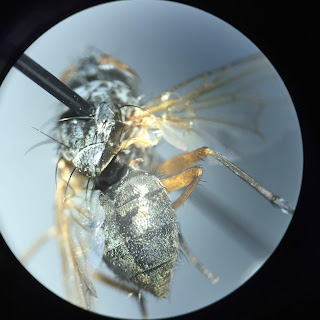Let’s talk about nomenclature for a second... Lots of species’ scientific names are composed of Greek words that somehow describe the group or a defining feature of the group. A bunch of insect groups include the ending –ptera because, you guessed it, most insects have wings! The scientific name of flies is DIPTERA, which should be relatively easy to decipher... it means TWO WINGS!
But wait a minute, you may be saying to yourself, all winged insects have 4 wings right?! Yes they do, BUT one pair of wings can sometimes be modified into other structures. If you remember from beetles 🐞, the forewing has been modified into elytra and they use only their hindwings to fly. Well in flies, the hindwings have been modified and they use only their forewings to fly. The second wing pair has been reduced to small structures called HALTERES.
- Halteres oscillate rapidly during flight, detecting rotations and perturbations. Flies use sensory information from their halteres to interpret their POSITION IN SPACE
- The SHAPE of halteres varies between species but they generally look like little clubs or bulbs (see photo). In some species (like crane flies) the halteres are very long and visible with the naked eye but in other species they may be hard to spot, even with a microscope, because they are very small or are covered by little flaps of the forewing
- Surgical removal of the halteres has been shown to affect equilibrium
- Science has traced the formation of halteres back to a SINGLE GENE! Put in very simple terms, the gene ULTRABITHORAX (Ubx) is part of a group of genes responsible for the body layout in insects, known as HOX genes. In other insects, Ubx plays a role in hindwing development but in flies, Ubx is responsible for the formation of halteres. So by turning certain genes on or off, scientists can actually create mutant flies with 4 wings!


Comments
Post a Comment